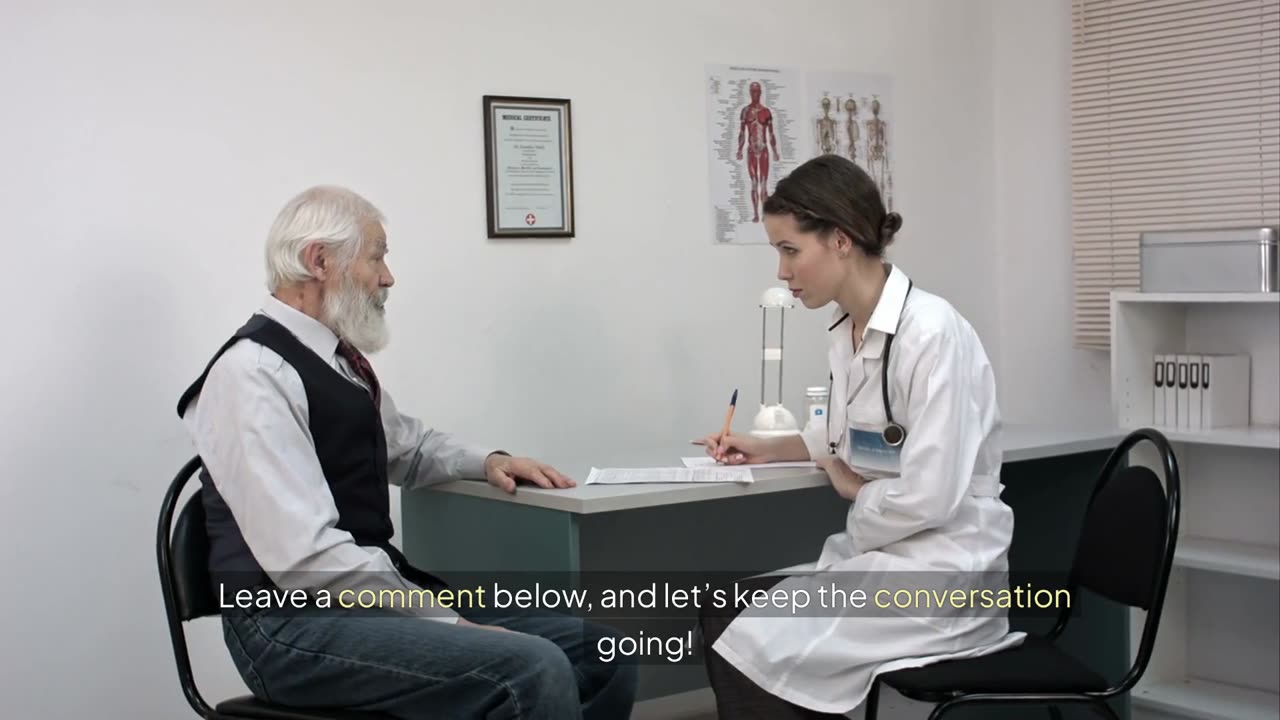Premium Only Content

Stroke Prevention: Your Essential Guide to Reducing Stroke Risk
**Introduction**
Imagine a world where up to 80% of strokes could be prevented. New guidelines now suggest that many strokes can indeed be avoided with simple lifestyle changes, improved health awareness, and, in some cases, medication. With stroke being the fourth leading cause of death in the U.S., it’s time to understand what’s really at stake and how you can protect yourself. From a balanced diet to innovative medications, here’s your essential guide to understanding and following the latest stroke prevention recommendations.
---
### 1. **Understanding Stroke: What It Is and Why It Happens**
A stroke can be life-altering or even fatal, but what exactly happens during one? A stroke occurs when blood flow to a part of the brain is blocked, either by a clot or a ruptured blood vessel. This deprivation of oxygen can cause immediate and lasting brain damage, leading to difficulty with speaking, thinking, walking, or worse. Unlike many health conditions, a stroke has a clear and swift impact on the brain, leaving little room for error. Understanding the causes of stroke is the first step to prevention, and the new guidelines emphasize that most people have the power to reduce their own risk.
The statistics are startling: each year, more than half a million Americans experience a stroke, and it’s among the leading causes of death in the U.S. But what if there was a way to avoid joining that number? The good news is that with these new stroke prevention guidelines, there is — and it starts with making healthier choices.
### 2. **Eat Your Way to a Healthier Heart: The Mediterranean Diet and Stroke Prevention**
Diet plays a crucial role in stroke prevention, and the Mediterranean diet has emerged as a top recommendation. This diet focuses on foods like fruits, vegetables, whole grains, and olive oil, which have all been shown to help reduce cholesterol, a major risk factor for stroke. The American Stroke Association encourages people to limit their intake of red meat and saturated fats, opting instead for protein sources like fish, nuts, and beans.
By embracing the Mediterranean diet, you’re not just eating delicious, wholesome foods; you’re actively working to keep your arteries clear and reduce your risk of stroke. Reducing processed foods and sugary drinks is another important step in maintaining a healthy weight, which, in turn, helps manage cholesterol and blood pressure. The bottom line? What you put on your plate can be one of your most effective tools for stroke prevention.
### 3. **Move for Your Life: How Physical Activity Can Help Prevent Stroke**
When it comes to reducing stroke risk, exercise is key. Experts recommend that even modest activity — just 10 minutes a day of walking — can help lower your risk. Regular physical activity helps regulate blood pressure, a major factor in stroke risk, and it’s also a natural way to combat stress, obesity, and high blood sugar. The American Stroke Association advises aiming for 150 minutes of moderate aerobic activity each week or 75 minutes of more intense exercise.
You don’t need to spend hours in the gym; finding a physical activity you enjoy can make it easier to stick with a routine. Walking, running, dancing, or even gardening can all contribute to a more active, heart-healthy lifestyle. Think of each step you take as a small investment in a stroke-free future.
### 4. **New Medications: Innovative Tools for Managing Weight and Stroke Risk**
While diet and exercise are foundational to stroke prevention, there are times when additional tools are necessary. Obesity is a significant risk factor for stroke, and the new guidelines recognize the role of recently approved medications that can help people manage their weight. Drugs like Ozempic, Wegovy, and Mounjaro have shown promise in aiding weight loss, especially in individuals with obesity or diabetes, conditions that can increase stroke risk.
These medications aren’t a quick fix, but they can offer additional support for those struggling with weight-related health issues. However, even with the assistance of medication, diet and exercise remain essential. As Dr. Fadi Nahab, a stroke specialist, notes, these medications work best when used alongside a healthy lifestyle. Discussing these options with a doctor can be an important step for those seeking additional ways to manage stroke risk.
### 5. **Broadening Our Approach: Social and Economic Factors in Stroke Risk**
Not everyone has equal access to healthcare, and factors like economic stability, race, and gender can influence stroke risk. The new guidelines address this disparity, recommending that doctors consider a patient's social and economic background when assessing stroke risk. For example, Black adults in the U.S. are nearly twice as likely to have a first stroke as white adults, largely due to a combination of socioeconomic and healthcare access factors.
Understanding these influences can help healthcare providers connect patients with resources like affordable health services, transportation options, and accessible exercise programs. The guidelines also encourage doctors to pay attention to stroke risk factors unique to women, such as high blood pressure during pregnancy or early menopause. These steps are intended to create a more inclusive approach to stroke prevention, where everyone has the opportunity to access the care and resources they need.
### 6. **Knowing the Warning Signs: How to Recognize and Respond to a Stroke**
Stroke symptoms can strike without warning, and recognizing them quickly can be the difference between life and death. The acronym FAST is a valuable tool for spotting stroke symptoms: **F** for face drooping, **A** for arm weakness, **S** for speech difficulties, and **T** for time — meaning it’s critical to call 911 immediately. Time is of the essence when treating a stroke; the faster medical intervention is received, the better the chances of minimizing brain damage.
Keeping the FAST acronym in mind can help you act quickly, potentially saving a life. These new guidelines also emphasize the importance of educating the public on stroke symptoms, as every second counts. It’s essential not only to protect yourself but also to help those around you recognize and respond to stroke warning signs.
---
**Conclusion: Take Control of Your Health with the Latest Stroke Prevention Guidelines**
Preventing a stroke is within reach for most people, and the new guidelines provide a clear path. From following a healthy diet and getting regular exercise to recognizing the importance of social and economic factors, there are practical steps that anyone can take to lower their stroke risk. Innovations in medication also offer new avenues for those at higher risk, making stroke prevention more accessible than ever.
Protect yourself and your loved ones by adopting these guidelines. By staying informed and proactive, you can help safeguard your health and build a lifestyle that supports long-term well-being. If you found this information helpful, please **like, share, and subscribe** for more tips on living a healthier life. And let us know in the comments: What steps are you taking to reduce your stroke risk? Let’s start the conversation on stroke prevention together!
-
 1:18:10
1:18:10
Graham Allen
4 hours agoPutin Vows Peace With Trump But WAR Under Biden!! + 400,000 Kids Are MISSING?!
74.4K134 -
 2:11:07
2:11:07
Matt Kohrs
11 hours agoMSTR Squeezes Higher, Bitcoin To $100k & Nvidia Post Earnings || The MK Show
30.3K1 -
 42:07
42:07
BonginoReport
5 hours agoNikki Haley's Hatred of Tulsi Gabbard Just Made Me a Bigger Fan (Ep.90) - 11/21/24
78.2K179 -
 28:41
28:41
Professor Nez
10 hours ago🚨BLOOD on their HANDS! The Man Biden & Kamala Flew In Finally Faces JUSTICE for Laken Riley
37.6K24 -
 1:06:27
1:06:27
2 MIKES LIVE
3 hours agoThe Mike Schwartz Show 11-21-2024
37.1K -
 15:07
15:07
PMG
12 hours ago $0.69 earned"President Trump's Cabinet is Amazing!"
44.9K -
 LIVE
LIVE
Vigilant News Network
15 hours agoHeavily-Vaxxed County Faces Grim Reality | The Daily Dose
1,139 watching -
 1:22:22
1:22:22
Game On!
15 hours ago $11.32 earnedRussell Wilson MVP? TNF Steelers vs Browns Game of the Year!
73.7K -
 13:57
13:57
This Bahamian Gyal
16 hours agoSo, now MIKA and JOE want to work with HITLER? Sunny Hostin was right!
45.5K45 -
 59:38
59:38
The Tom Renz Show
19 hours ago"MAGA & Unity With Pastor Bernadette Smith"
29.7K2